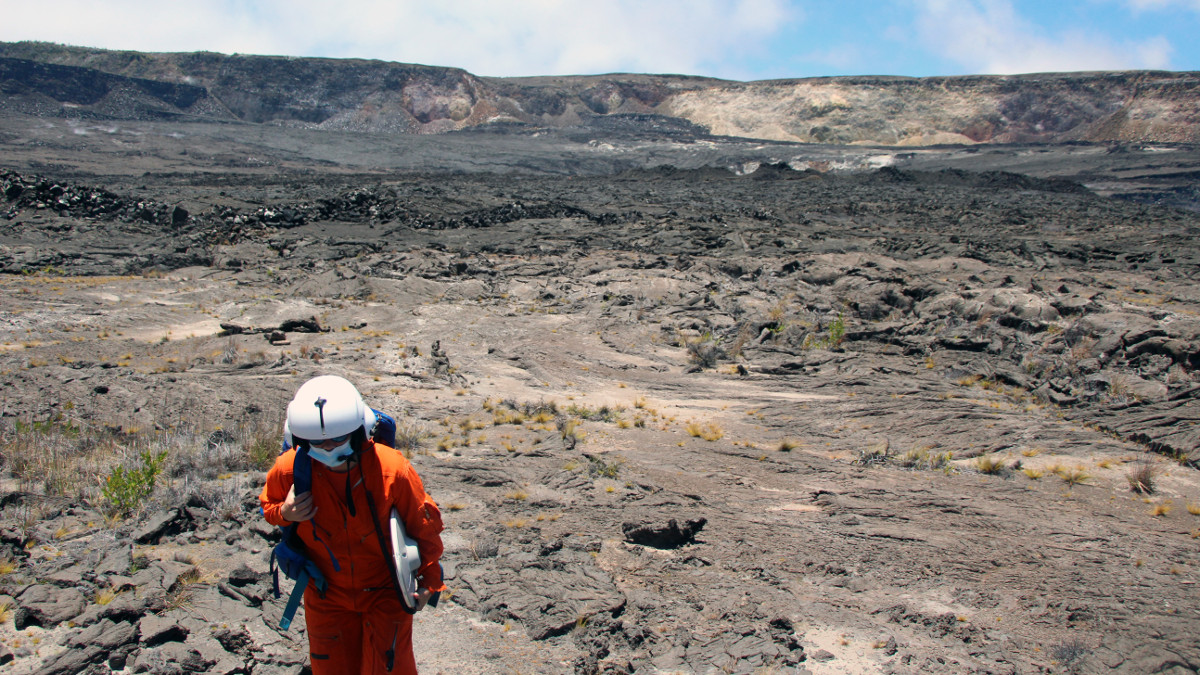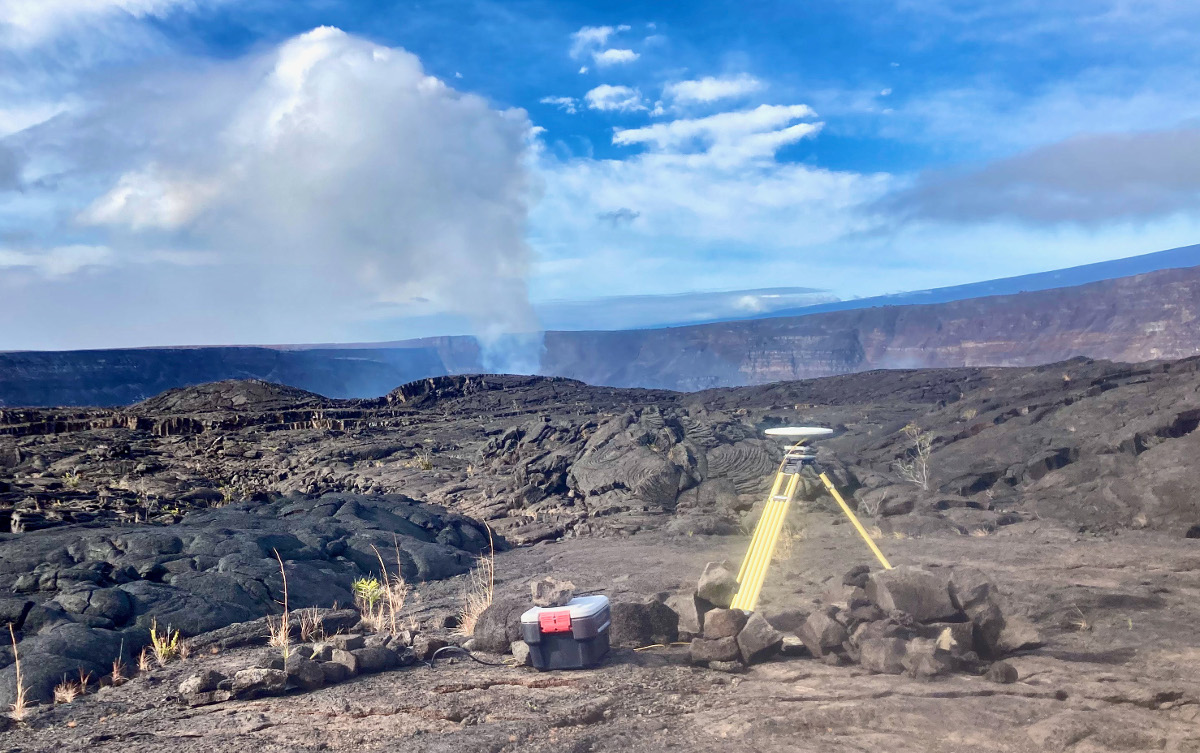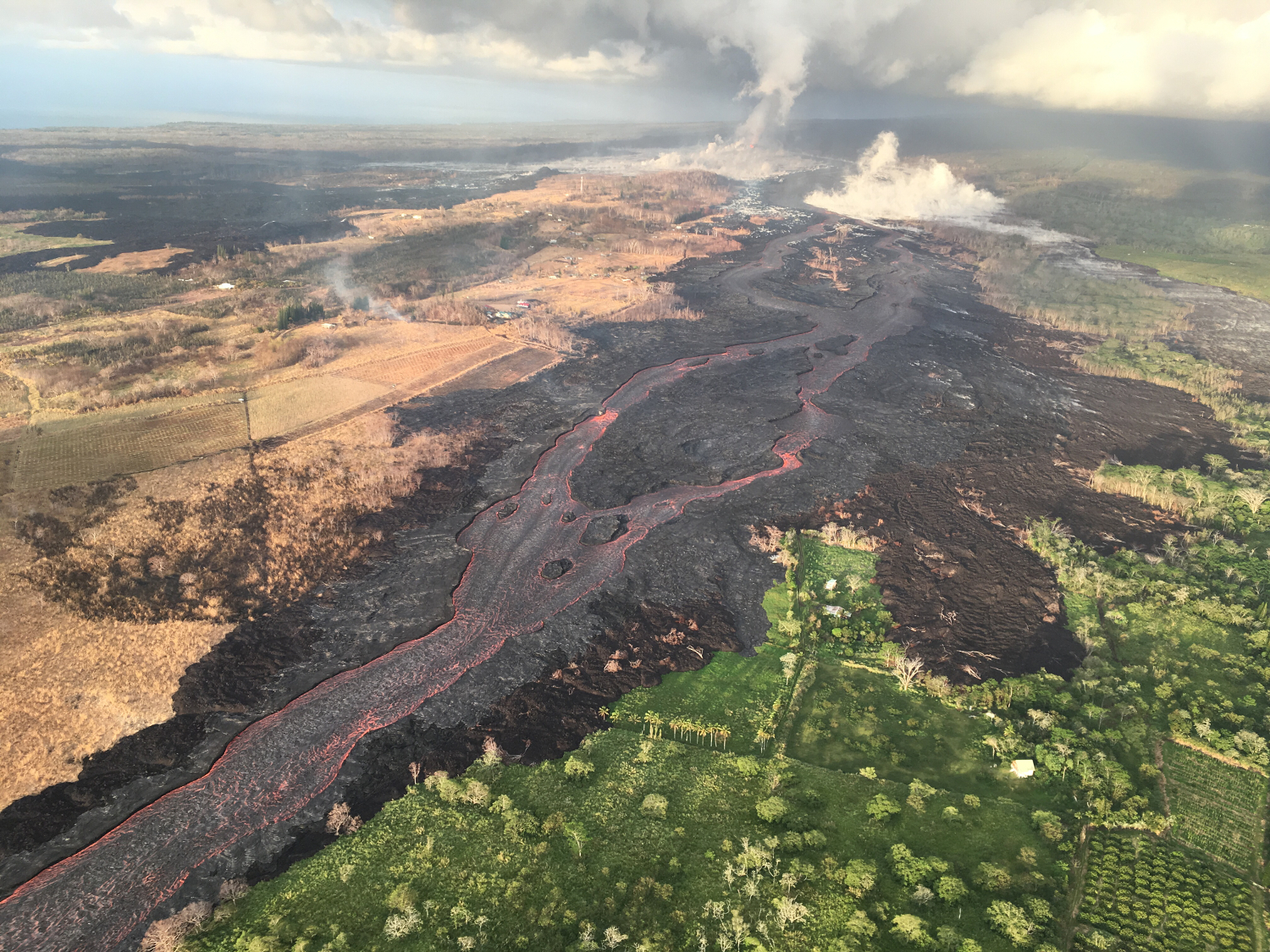
USGS: “On June 8, 2021, the USGS Hawaiian Volcano Observatory conducted a routine helicopter overflight and fieldwork at the summit of Kīlauea. Here, a geophysicist returns to the helicopter after making Global Positioning Systems (GPS) measurements.” USGS photo by C. Parcheta.
(BIVN) – The summit eruption of Kīlauea Volcano continued over the past 24 hours, with all activity confined to Halemaʻumaʻu crater.
Scientists have not observed any significant changes at the summit or in either rift zone, and the U.S. Geological Survey Hawaiian Volcano Observatory continues to closely monitor Kīlauea Volcano.
This week’s Volcano Watch, written by USGS HVO scientists and affiliates, details one of those critical monitoring networks. From the article:
The USGS Hawaiian Volcano Observatory’s (HVO’s) geodetic network is actively being upgraded to help scientists monitor and respond to volcanic activity. In the four years since the 2018 Kīlauea lower East Rift Zone eruption and summit collapse, HVO has been working to rebuild the monitoring network and provide other updates as part of the Additional Supplemental Appropriations for Disaster Relief Act of 2019 (H.R. 2157).
Before describing specific updates to the geodetic network at HVO, let’s first explore and define what we mean by ‘geodesy’ and the way we measure surface deformation in geoscience.
Geodesy is the study of measuring and understanding how the Earth’s surface deforms and changes. The main geodetic datasets currently used by HVO scientists to measure surface deformation (ground movements) are GNSS (global navigation satellite system, which includes GPS), tilt, and satellite radar (InSAR) imagery.
HVO’s geodetic monitoring network includes over 70 GNSS stations and 15 tiltmeters on the Island of Hawai’i that continuously record and transmit data. These instruments require routine maintenance, must be upgraded periodically due to age, and must be replaced if destroyed by volcanic activity such as in 2018.
Current upgrades focus on rebuilding and improving HVO’s geodetic network in order to better detect, assess, and respond to volcanic hazards related to Hawaiian Volcanoes. Some of the network upgrades include replacing out-of-date instruments and improving HVO’s network of near real-time monitoring instruments at critical areas on Kīlauea’s summit and rift zones to support early detection of magma movement and associated hazards.
In 2018, lava flows destroyed 3 GNSS stations in the lower East Rift Zone. Another 3 GNSS stations were destroyed in the caldera collapses at Kīlauea’s summit. HVO staff rapidly deployed new GNSS stations at nearby locations to allow for continued monitoring during the 2018 crisis. These rapidly deployed sites included GNSS antennas mounted on surveys tripods, which is a set-up typically only used for temporary deployments that last several days to weeks.
Many of these rapidly deployed sites were decommissioned and removed after 2018. However, approximately 13 of them are still being used for critical monitoring and remain on temporary tripods. These sites will be upgraded and hardened using engineered fixed monuments and masts instead. New sites will also be installed to replace sites destroyed in 2018.
GNSS receivers acquired by Supplemental funds have already supported emergency monitoring of active eruptions and other volcano-related activity. Data from these instruments help HVO detect volcanic activity and inform partners at Hawai’i Volcanoes National Park (HAVO), Hawai’i County Civil Defense (HCCD) and Hawai’i Emergency Management Agency (HI EMA).
For example, HVO rapidly deployed 3 new semi-continuous GNSS stations in response to the December 2020 Kīlauea eruption. These stations gave scientists a more complete view of magma returning to Kīlauea’s summit.
Similarly, HVO deployed rapid-response GNSS equipment at 2 pre-existing benchmarks during the Kīlauea south caldera intrusion event in August 2021, allowing scientists to track the migration of magma from the south caldera to farther south. New instruments give HVO a more detailed understanding of and ability to monitor Kīlauea’s volcanic processes.
HVO’s geodesy program plays a critical role in monitoring Hawaiian volcanoes. HVO’s updated geodetic network ensures that scientists can monitor changes in the shape of volcanoes, respond to eruptions, and understand magma storage and movement underground.
Thanks to Supplemental funding, HVO is in the best position ever to leverage our state-of-the-art geodetic network to gain insights into the active volcanoes in Hawai’i, assess their hazards, issue warnings, and advance scientific understanding to reduce the impacts of volcanic eruptions.



by Big Island Video News10:12 am
on at
STORY SUMMARY
HAWAIʻI VOLCANOES NATIONAL PARK - HVO has been working to rebuild the monitoring network and provide other updates as part of the Additional Supplemental Appropriations for Disaster Relief Act of 2019.